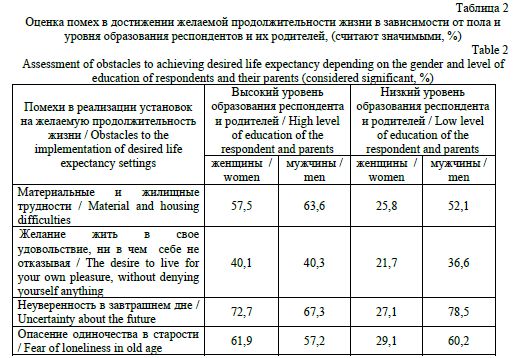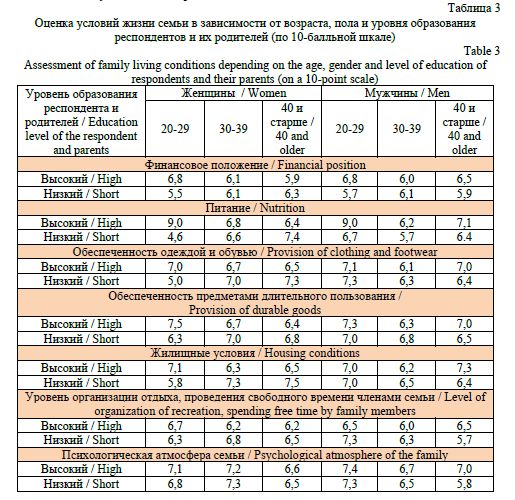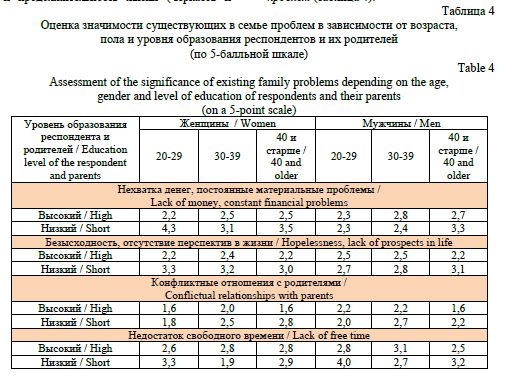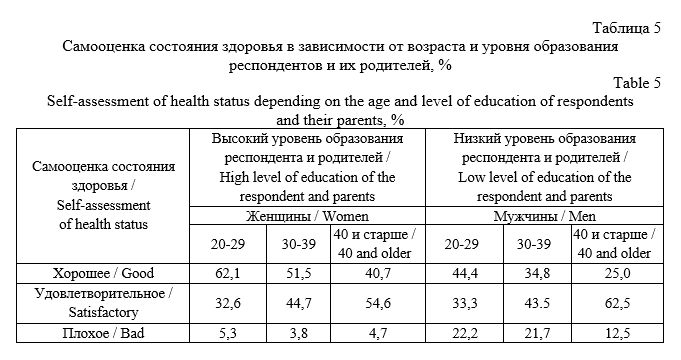The influence of the level of education of children and their parents on individual aspects o f self-preservation behavior, taking into account age dynamics
The study of education as a factor influencing various aspects of self-preservation behaviour is due to its role in exacerbating or alleviating inequalities in physical, social, and mental health. Particularly relevant is the study of the relationship between health characteristics and the educational level of family members in age dynamics, which expands the understanding of the determinants of self-preservation behavior and is important in the context of the implementation of family and demographic policy aimed at strengthening the values of family and active longevity. The results obtained from the analysis of data from the comprehensive sociological study 'Demographic Well-Being of Russia', which was conducted in ten regions of Russia between 2019 and 2020, demonstrate a non-linear relationship between the age and education level of children and their parents, and indicators of attitudes towards individual life expectancies, the obstacles to achieving them, the assessment of living conditions, family life and health. A stable correlation was found between the level of education and indicators of the subjective assessment of obstacles to achieving the desired life expectancy (which were rated higher by more educated people than by their less educated peers), as well as existing problems in respondents' families (which were, on the contrary, given lower ratings by respondents with a higher level of education). Contradictory results were obtained with regard to attitudes towards desired and expected life expectancy, assessment of living conditions and self-assessment of health. These results were characterised by age and/or educational differentiation, indicating the need for additional quantitative and qualitative research aimed at expanding understanding of the influence of educational level on individual aspects of self-preservation behaviour, taking into account age dynamics.
Figures







Ivanova, A. E., Vangorodskaya, S. A. (2025), “The influence of the level of education of children and their parents on individual aspects of self-preservation behavior, taking into account age dynamics”, Research Result. Sociology and management, 11 (3), 185-202. DOI: 10.18413/2408-9338-2025-11-3-1-1.


















While nobody left any comments to this publication.
You can be first.
Andreev, E. M., Dobrovolskaya V. M. (1993), “Social differentiation of mortality in Russia”, Zdravookhranenie Rossiyskoy Federatsii, (9), 18-21. (In Russian)
Antonov, A. I. (2005), Mikrosotsiologiya semi [Microsociology of the family], INFRA-M, Moscow, Russia.
Zhuravleva, I. V. (2006), Otnoshenie k zdorovyu individa i obshhestva [Attitude to health of the individual and society], Nauka, Moscow, Russia, ISBN: 5-02-035368-X, EDN: QOGCOH.
Ivanova, A. E., Zemlyanova, E. V., Mixajlov, A. Yu., Golovenkin, S. E. (2014), “Differences in adult mortality in Russia by level of education”, Zdravookhranenie Rossiyskoy Federatsii, 58 (2), 4-8, EDN: SCLJQD. (In Russian)
Ivanova, E. I. (2014), “Structural and social factors of health of the population of Russia”, Vestnik RGGU. Seriya «Cotsiologicheskie nauki», (4), 138-155, EDN: SGMAXZ. (In Russian)
Kaneva, M. A. (2016), “Socioeconomic, behavioral and psychological determinants of self-assessment of health of Russians”, Natsionalnye interesy: prioritety i bezopasnost, 12(6), 158-171, EDN: TVSCHL. (In Russian)
Karpova, G. V., Sudova, T. L., Shirshikova, M. S. (2023) “Health capital and its measurement”, Problemy sovremennoy ekonomiki, 2 (86), 36-41, EDN: MYLOLU. (In Russian)
Kislitsyna, O. A. (2017), “Socioeconomic inequalities in health: trends and hypotheses”, Sotsialnye aspekty zdorovya naseleniya, 2 (54), 1, EDN: YRHKJR. (In Russian)
Kislitsyna, O. A. (2018), “Russians' perception of injustice and inequality in access to health services and the factors that determine it”, Sotsialnye aspekty zdorovya naseleniya, 3(61), 4, EDN: UUSABK. (In Russian)
Kislitsyna, O. A. (2023), “Social differences in the health status of Russians: the role of material, psychosocial and behavioral factors”, Sotsialnye aspekty zdorovya naseleniya, 69(3), № 3, EDN: OZQMBI. (In Russian)
Kovalzhina, L. S. diskurs (2019), “Health Inequality: A Sociological Discourse”, Sotsiodinamika, 6, Online, available at: https://nbpublish.com/library_read_article.php?id=29868 (Accessed 12 May 2024). (In Russian)
Kozyreva, P. M., Smirnov, A. I. (2020), “Dynamics of Russians' self-assessments of health: current trends of the post-Soviet period”, Sotsiologicheskie issledovaniya, (4), 70-81, DOI: 10.31857/S013216250009116-0, EDN: MLJZHL. (In Russian)
Moiseeva, D. Yu., Troiczkaya, I. A. (2019), “Socioeconomic determinants of health”, Vestnik Tyumenskogo gosudarstvennogo universiteta. Sotsialno-ekonomicheskie i pravovye issledovaniya, 5 (3), 42-59, DOI: 10.21684/2411-7897-2019-5-3-42-59, EDN: ZTLPIW. (In Russian)
Pol, P., Valtonen, X., Kovtun, N. V. (2019), “Socioeconomic inequality of the population in health in post-Soviet Russia”, Narodonaselenie, 22 (1), 61-78, DOI: 10.24411/1561-7785-2019-00005, EDN: CQAUQD. (In Russian)
Pyankova, A. I., Fattakhov, T. A. (2017), “Mortality by level of education in Russia”, Ekonomichesky zhurnal Vysshey shkoly ekonomiki, 21 (4), 623-647, EDN: YLBIXB. (In Russian)
Rusinova, N. L. (2019), “Social inequalities in health: the mediating role of material deprivation and psychological resources”, Demograficheskoe obozrenie, 6 (3), 6-30, EDN: JTCQCC. (In Russian)
Rusinova, N. L., Safronov, V. V. (2016), “Social risks of depression in Europe and Russia: the importance of demography, education and social capital”, Sotsiologichesky zhurnal, 22 (3), 82-106, DOI: 10.19181/socjour.2016.22.3.4586, EDN: WXDJWP. (In Russian)
Khabibullina, A. R., Aleksandrova, E. A., Aistov, A. V. (2021), “Estimates of health inequality among Russians”, Voprosy jekonomiki, (3), 117-138, DOI: 10.32609/0042-8736-2021-3-117-138, EDN: TGEWCC. (In Russian)
Kharkova, T. L., Nikitina, S. Yu., Andreev, E. M. (2017), “Dependence of life expectancy on the level of education in Russia”, Voprosy statistiki, (8), 61-69, EDN: ZGQIDL. (In Russian)
Cherkasov, S. N., Kirtadze, I. D. (2018), “The influence of family environment as a social determinant of health on health status in different age and sex groups”, Evrazyskoe Nauchnoe Ob#edinenie, 3-2 (37), 116-118, EDN: YVSWGW. (In Russian)
Cherkasov, S. N., Martirosov, A. V., Kamaev, Yu. O., Fedyaeva, A. V. (2023), “Sources of information used by patients with different levels of education when choosing a doctor”, Kardiovaskulyarnaya terapiya i profilaktika, 22 (S6), 74, EDN: HMQOQH. (In Russian)
Cherkasov, S. N., Sopova, I. L. (2020), “The Impact of Education Level on Self-Assessment of Health in Women of Reproductive Age”, Vestnik Severo-Vostochnogo federalnogo universiteta im. M.K. Ammosova. Seriya: Meditsinskie nauki, 4 (21), 67-71, DOI: 10.25587/SVFU.2020.21.4.009, EDN: KGESJD. (In Russian)
Cherkasov, S. N., Sopova, I. L., Polozkov, O. I. (2021), “The Impact of Education Level as a Social Determinant of Health on the Prevalence of Health-Saving Behaviors”, Byulleten Natsionalnogo nauchno-issledovatelskogo instituta obshhestvennogo zdoroya imeni N.A. Semashko, (2), 100-107, DOI: 10.25742/NRIPH.2021.02.012, EDN: ABDUCS. (In Russian)
Adler, N. E. (2007), “Reaching for a healthier life: Facts on socioeconomic status and health in the US”, MacArthur Foundation Research Network on Socioeconomic Status and Health.
Currie, J. (2006), “Child health and human capital”, NBER Reporter Online, National Bureau of Economic Research (NBER), Cambridge, MA, Iss. Spring, 11-14, Online, available at: https://www.econstor.eu/bitstream/10419/61891/ 1/687943523.pdf (Accessed 21 September 2024).
Cutler, D. M., Lleras-Muney, A. (2010), “Understanding differences in health behaviors by education”, Journal of Health Economics, 29 (1), 1-28.
Grossman, M. (1972), “On the Concept of Health Capital and the Demand for Health”, Journal of Political Economy, 80 (2), 223-255.
Grossman, M. (1998), “On optimal length of life”, Journal of Health Economics, 17, 499-509.
Lynch, J. W., Smith, G. D., Kaplan, G. A., House, J. S. (2000), “Income inequality and mortality: importance to health of individual income, psychosocial environment, or material conditions”, British Medical Journal, 320 (7243), 1200-1204.
Mackenbach, J. P. (2012), “The Persistence of Health Inequalities in Modern Welfare States: The Explanation of a Paradox”, Social Science and Medicine, 75 (4), 761-769.
Monden, C.W.S. (2010), “Do measured and unmeasured family factors bias association between education and selfassessed health?”, Social Indicators Research, 98 (2), 321-336.
Valkonen, T. (1993), Problems in the Measurement and International Comparisons of Socio-economic Differences in Mortality, Social Science and Medicine, 36 (4), 409-418.